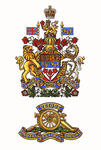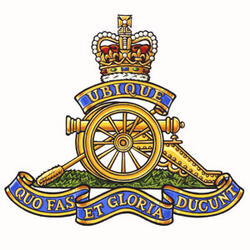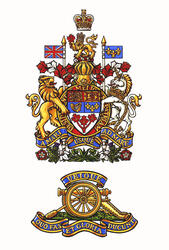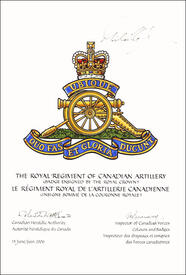The contents of this Register are intended for research purposes only. The heraldic emblems found in the Register may not be reproduced in any form or in any media without the written consent of the Canadian Heraldic Authority and/or the recipient.
Shilo, Manitoba
Approval of a Badge
June 15, 2006
Vol. V, p. 61
Badge of The Royal Regiment of Canadian Artillery surmounted by the Royal CrownBlazonA field gun Or on a grassy mount Vert, ensigned by the Royal Crown; SymbolismHer Majesty the Queen of Canada did approve that this Badge and Mottoes may be borne ensigned by the Royal Crown or by the Royal Arms of Canada. By 1867, the 9-pounder smooth bore muzzle loader was the principal gun of Canadian artillery field batteries, the first of which were formed in 1855. This gun was also the initial equipment of “A” and “B” Batteries when they became the first full-time (regular) Militia units in 1871. The similarity to the Royal Artillery badge emphasizes the close traditional ties between the two regiments. “UBIQUE” and “QUO FAS ET GLORIA DUCUNT” are the regimental mottoes. |
MottoBlazonUBIQUE; SymbolismMeaning "Everywhere". |
MottoBlazonQUO FAS ET GLORIA DUCUNT; SymbolismMeaning “Whither duty and glory lead”. |
Badge of The Royal Regiment of Canadian Artillery, surmounted by the Royal Arms of CanadaBlazonA field gun Or on a grassy mount Vert, ensigned by the Royal Arms of Canada; SymbolismHer Majesty the Queen of Canada did approve that this Badge and Mottoes may be borne ensigned by the Royal Crown or by the Royal Arms of Canada. By 1867, the 9-pounder smooth bore muzzle loader was the principal gun of Canadian artillery field batteries, the first of which were formed in 1855. This gun was also the initial equipment of “A” and “B” Batteries when they became the first full-time (regular) Militia units in 1871. The similarity to the Royal Artillery badge emphasizes the close traditional ties between the two regiments. “UBIQUE” and “QUO FAS ET GLORIA DUCUNT” are the regimental mottoes. |







